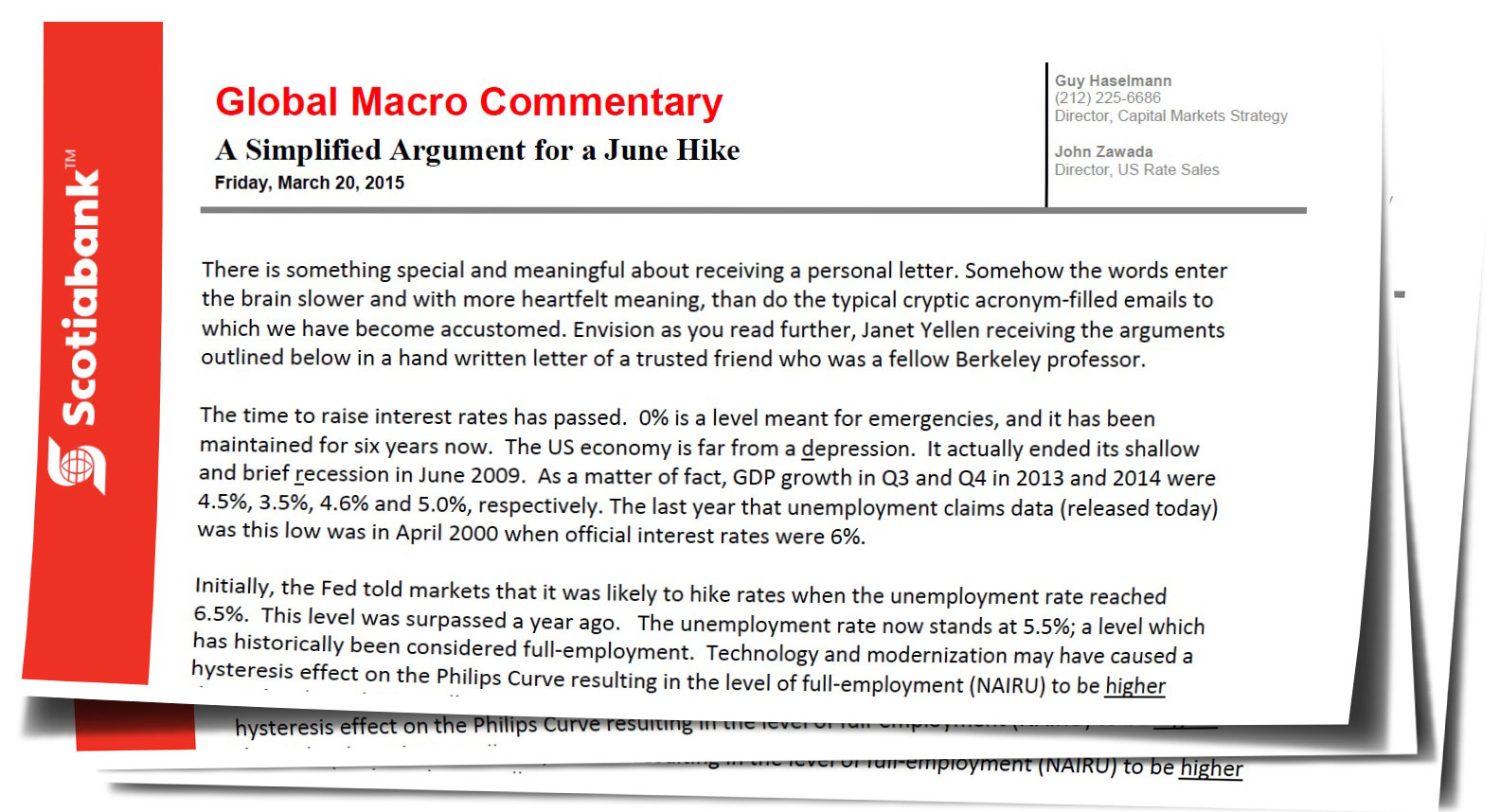by Guy Haselmann, Director, Capital Markets Strategy, Scotiabank GBM
There is something special and meaningful about receiving a personal letter. Somehow the words enter the brain slower and with more heartfelt meaning, than do the typical cryptic acronym-filled emails to which we have become accustomed. Envision as you read further, Janet Yellen receiving the arguments outlined below in a hand written letter of a trusted friend who was a fellow Berkeley professor.
The time to raise interest rates has passed. 0% is a level meant for emergencies, and it has been maintained for six years now. The US economy is far from a depression. It actually ended its shallow and brief recession in June 2009. As a matter of fact, GDP growth in Q3 and Q4 in 2013 and 2014 were 4.5%, 3.5%, 4.6% and 5.0%, respectively. The last year that unemployment claims data (released today) was this low was in April 2000 when official interest rates were 6%.
Initially, the Fed told markets that it was likely to hike rates when the unemployment rate reached 6.5%. This level was surpassed a year ago. The unemployment rate now stands at 5.5%; a level which has historically been considered full-employment. Technology and modernization may have caused a hysteresis effect on the Philips Curve resulting in the level of full-employment (NAIRU) to be higher than it has been historically.
The Fed has been accused in the past of fomenting boom-to-bust cycles. The argument is that the Fed was too slow to act during past cycles. Regardless, the basic problem has always been that it is easier to provide stimulus than it is to take it away. Unfortunately, this is the reason why the Fed has stair-stepped rates over the years down to 0% (the zero lower bound), and why the Fed finds itself in its current quagmire.
Today’s policy is different and more problematic, because its financial repression, by its very nature, lifts asset prices and encourages risk taking. This means that extracting the Fed from today’s policy stance without a ‘bust’ will be far more challenging. Former FOMC member Jeremy Stein warned about some of these risks which may be why FOMC member prudently use words like ‘gradual’ and ‘measured’ when discussing rate ‘normalization’.
At Milton Friedman’s 90th birthday party in 2002, Dr. Bernanke said, “Let me end my talk by abusing slightly my status as an official representative of the Federal Reserve. I would like to say to Milton, regarding the Great Depression, you’re right, we did it. We’re very sorry. But thanks to you, we won’t do it again”. The former Chairman was clearly serious about the Fed using every tool available to ensure such a fate was avoided.
Dr. Bernanke published numerous academic journals analyzing the Great Depression. Yet, is it possible that the current template for dealing with the 2008 crisis may not have been the 1930’s as he suggests, but rather the 1921/22 period, as advocated by Jim Grant? Maybe Dr. Bernanke’s extensive work caused him to envision a depression, or a materially negative deflation, that had little chance of materializing (particularly after 2011).
I worry that the Fed could manufacture one (i.e. a depression) by eventually convincing everyone through maintaining a ZIRP policy that one is still lurking. I also worry that the Fed could create one by itself becoming a source of financial instability, where too much encouragement of credit-fueled growth and speculative risk-taking leads to a major ‘bust’.
Last Friday, Janet Yellen gave a thoughtful 4292 word speech. It included every contingency imaginable. I believe what I heard her say in my Cliff Notes version is that, ‘Everything is uncertain, but we are looking at everything. There are risks no matter what we do, so we will not hike too fast, too slow, too much, or too little; and, oh, we could ease too if necessary.’
The speech emphasized the extent of the FOMC’s flexibility and caution. However, many are beginning to believe that the Fed has run out of credible excuses for not hiking. Conditions justifying a hike have existed for well over a year. By continuing to wait, the Fed risks a deterioration in market conditions, economic activity, and/or the geo-political environment, potentially derailing the opportunity and the FOMC’s stated desire to move away from the zero lower bound.
In conclusion, the economy is not in the midst of a crisis that warrants 0%. FOMC indecisiveness has turned into a source of confusion and uncertainty to markets. It is a distraction to investors and an impediment to capital investment decisions. It has simply become counter-productive.
Micro-managing a highly-complex $18 trillion economy is futile. If six years of 0% rates and $3.8 trillion of asset purchases have not done the trick by now, then waiting a few more months is unlikely to make any difference. If the economy gets derailed by not being able to handle a mere 0.25% rate rise, then we are all in big trouble. Markets…well they are a different story.
“May the force be with you.” – Yoda
Have a nice holiday weekend.
Guy
Guy Haselmann | Director, Capital Markets Strategy
▬▬▬▬▬▬▬▬▬▬▬▬▬▬▬▬▬▬▬▬▬▬▬▬▬▬▬
Scotiabank | Global Banking and Markets
250 Vesey Street | New York, NY 10281
T-212.225.6686 | C-917-325-5816
guy.haselmann[at]scotiabank.com
Read/Download the complete report below:
Global Macro Commentary April 2(1)
Copyright © Scotiabank GBM















